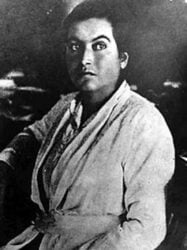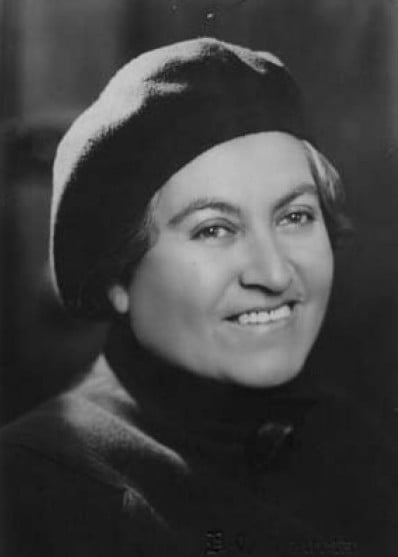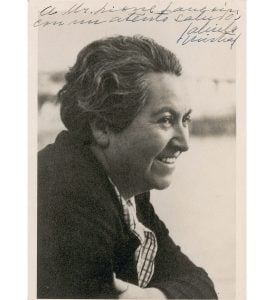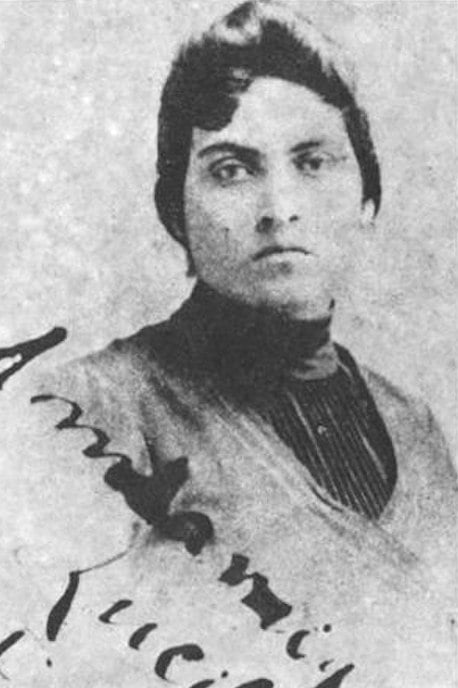The Poetry of Gabriela Mistral: A Brief Overview and Analysis
By Nava Atlas | On April 24, 2020 | Updated January 3, 2023 | Comments (4)

Gabriela Mistral (Lucila Godoy Alcayaga, 1889 – 1957), the Chilean poet, educator, diplomat, and feminist was the first Latin American to receive the Nobel Prize in Literature. Here, we’ll take a concise look at the poetry of Gabriela Mistral — an overview of her published works and analysis of major themes.
She was cited “for her lyric poetry which, inspired by powerful emotions, has made her name a symbol of the idealistic aspirations of the entire Latin American world.”
Born in Vicuña, Chile, Mistral had a lifelong passion for eduction and gained a reputation as the nation’s “national schoolteacher-mother.” That she hasn’t retained a literary stature comparable to her countryman, Pablo Neruda, is surprising, given her Nobel Prize and many other achievements and accolades.
. . . . . . . . . . .

Learn more about Gabriela Mistral
. . . . . . . . . . .
First, an overview of Mistral’s poetic work, from A Queer Mother for the Nation by Licia Fiol Matta (University of Minnesota Press, 2002):
The published collections of Gabriela Mistral
Mistral’s oeuvre consists of six poetry books and several volumes of prose and correspondence. During her life, she published four volumes of poetry. Her first book, Desolación, was published in 1922 in New York City, under the auspices of Federico de Onís, professor of Spanish at Columbia University.
The book attracted immediate attention. Mistral’s second book of poems, Ternura (Tenderness), soon followed, in 1924, and was published in Spain, with Calleja Press. Three editions were printed before Ternura underwent a transformation and was reissued in 1945.
For its final form, Mistral removed all the lullabies and “children’s poems” that were originally part of Desolación and the later Tala, and put all the children’s poems in the definitive edition of Ternura. She also added poems written independently, some of which were markedly different from earlier, pedagogical celebrations of childhood.
Ternura became Mistral’s most popular and best-selling book. Her third, and perhaps most important, book is Tala (Felling; 1938). Dedicated to the Basque children orphaned during the Spanish civil war, the book was published by Victoria Ocampo’s prestigious publishing house Sur in Argentina, a major cultural clearinghouse of the day.
Tala was reissued in 1947. For this edition, Mistral took out all of the children’s poems and, as mentioned, placed them in a single volume, the 1945 edition of Ternura. This second edition is the definitive version we know today.
Mistral’s final book, Lagar (Wine Press), was published in Chile in 1954. Two posthumous volumes of poetry also exist: Poema de Chile (Poem of Chile; Santiago, 1967) and Lagar II (Wine press II; Santiago, 1991).
. . . . . . . . . . .

9 Poems by Gabriela Mistral About Life, Love, and Death
. . . . . . . . . . .
And here, from Gabriela Mistral: The Poet and Her Work by Margot Are de Vazquez (New York University Press, 1964) is an excellent brief analysis of Mistral’s body of poetic work:
Passion is the great central poetic theme
Gabriela Mistral’s poetry stands as a reaction to the Modernism of the Nicaraguan poet Rubén Darió (rubendarismo): a poetry without ornate form, without linguistic virtuosity, without evocations of gallant or aristocratic eras; it is the poetry of a rustic soul, as primitive and strong as the earth, of pure accents without the elegantly correct echoes of France.
By comparison with Hispanic-American literature generally, which on so many occasions has been an imitator of European models, Gabriela’s poetry possesses the merit of consummate originality, of a voice of its own, authentic and consciously realized.
The affirmation within this poetry of the intimate removed from everything foreign to it, makes it profoundly human, and it is this human quality that gives it its universal value.
Passion is its great central poetic theme; sorrowful passion similar in certain aspects—in its obsession with death, in its longing for eternity — to Unamuno’s agony; the result of a tragic love experience. Pathos has saturated the ardent soul of the poet to such an extent that even her concepts, her reasons are transformed into vehement passion.
The poet’s definition of her lyric poetry
The poet herself defines her lyric poetry as “a wound of love inflicted on us by things.” It is an instinctive lyricism of flesh and blood, in which the subjective, bleeding experience is more important than form, rhythm or ideas, it is a truly pure poetry because it goes directly to the innermost regions of the spirit and springs from a fiery and violent heart.
The second important poetic motif is nature, or rather, creation, because Gabriela sings to every creation: to man, animals, vegetables, and minerals; to active and inert materials; and to objects made by human hands. All beings have for her a concrete, palpable reality and, at the same time, a magic existence that surrounds them with a luminous aura.
In a single moment she reveals the unity of the cosmos, her personal relationship with creatures, and that state of mystic, Franciscan rapture with which she gathers them all to her.
. . . . . . . . . .
 . . . . . . . . . .
. . . . . . . . . .
Mistral’s children’s poems
There is also an abundance of poems fashioned after children’s folklore. The stories, rounds, and lullabies, the poems intended for the spiritual and moral formation of the students, achieve the intense simplicity of true songs of the people; there throbs within them the sharp longing for motherhood, the inverted tenderness of a very feminine soul whose innermost “reason for being” is unfulfilled.
These children’s poems are found in all her books as a repeated poetic motif, Gabriela deftly approaches the soul of the child avoiding the great danger of the adult point of view.
The marvelous narrative, the joy of free imagination, the affectionate, rhythmic language that at various times seems outcry, hallelujah, or riddle, all make of these poems authentic children’s poetry, the most beautiful that has emerged from the lips of any American or Spanish poet.
Expressing love for teaching and schools
Gabriela also expresses her love for school and for her work as a teacher. In the verses dealing with these themes, we can perceive her conception of pedagogy.
She viewed teaching as a Christian duty and exercise of charity; its function was to awaken within the soul of the student religious and moral conscience and the love of beauty; it was a task carried out always under the gaze of God.
More than twenty years of teaching deepened her capacity for understanding and her social, human concern. She never permitted her spirit to harden in a fatiguing and desensitizing routine. When there is a glimmer of pedagogy in her verses, it appears redeemed by fervor.
. . . . . . . . . .

The Early Poetry of Gabriela Mistral
. . . . . . . . . . .
Praise for the American lands
Her love and praise of American lands, memories of her Elqui valley, of Mexico’s Indians, and of the sweet landscape of tropical islands, and her concern for the historical fate of these peoples form another insistent leit-motif of her poetry.
No other poet, with the exception of Neruda in his songs to the Chilean land, has spoken with more emotion of the beauty of the American world and of the splendor of its nature.
Gabriela also wrote prose—pure creole prose, clothed in the sensuality of these lands, in their strength and sweetness; baroque Spanish, but a baroque more of tension and accent than language. She used this pithy, exaggerated, persuasive, frequently sharp prose for the work—her great ideal—of the solidarity of Hispanic nations.
A voice for liberty, justice, and peace
Once again one notes her kinship with Unamuno because Gabriela wished for a Hispanic-American union based on the common language, on a re-evaluation of the past that would fuse the Indian and Spanish heritage, and, above all, on moral strength and the critical examination of the present.
Although she did not take part in politics, because as a woman she detested exhibitionistic feminism, her voice was heeded because of its great moral prestige. She never sold her pen to dictators, she never floundered.
Her fearless and unhesitating defense of justice, liberty, and peace was especially admirable at a time when the defense of those values, thanks to the evil cunning of dangerous, modern nominalism, was looked upon with suspicion and fear.
Gabriela has left us an abundant body of poetic work gathered together in several books or scattered in newspapers and magazines throughout Europe and America, There surely exist numerous manuscripts of unpublished poems that should be compiled, catalogued, and published in a posthumous book.
Constantly writing and revising
Gabriela wrote constantly, she corrected a great deal, and she was a bit lax in publishing. Like Cóngora, she did not take much care in the preservation and filing of her papers. Once in a while we put them in order for her; we were certain that within a short time they would revert to their initial chaotic state.
Sixteen years elapsed between Desolation (Desolación) and Felling (Tala); another sixteen, between Felling and Wine Press (Lagar). Each one of these books is the result of a selection that omits much of what was written during those long lapses of time.
The time has now come to consider the compilation of her complete works; but to gather together so much material will be a slow, arduous task that will require the careful, critical polishing of texts.
More about Gabriela Mistral
Gabriela Mistral is a glory of Chile and the entire Hispano American World. She is comparable to the other Chilean Literature Nobel Prize Winner : Pablo Neruda
True, and she deserves to be better known. Thanks, Jose!
I love this! Very good analysis and summarize of Gabriela Mistral’s universe.
Thank you so much for your kind comment! More readers should know about Gabriela Mistral and her life’s work.